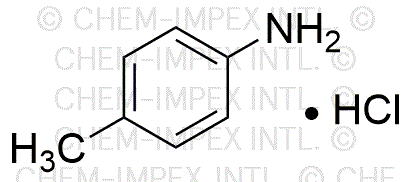4-Methylaniline hydrochloride is widely utilized in research focused on
- Dyes and Pigments: This compound serves as an important intermediate in the production of azo dyes, which are widely used in textiles and printing. Its ability to impart vibrant colors makes it a preferred choice in the dye industry.
- Pharmaceuticals: It is used in the synthesis of various pharmaceutical compounds, particularly in the development of analgesics and anti-inflammatory drugs. Its role in drug formulation can enhance therapeutic efficacy.
- Polymer Chemistry: The compound is utilized in the production of certain polymers and resins, contributing to materials with enhanced durability and chemical resistance, which are essential in coatings and adhesives.
- Analytical Chemistry: In laboratories, it is employed as a reagent for the detection and quantification of various substances, aiding researchers in developing accurate analytical methods.
- Research Applications: It is commonly used in organic synthesis and chemical research, allowing scientists to explore new reactions and develop innovative compounds, thus driving advancements in multiple fields.
General Information
Properties
Safety and Regulations
Applications
4-Methylaniline hydrochloride is widely utilized in research focused on
- Dyes and Pigments: This compound serves as an important intermediate in the production of azo dyes, which are widely used in textiles and printing. Its ability to impart vibrant colors makes it a preferred choice in the dye industry.
- Pharmaceuticals: It is used in the synthesis of various pharmaceutical compounds, particularly in the development of analgesics and anti-inflammatory drugs. Its role in drug formulation can enhance therapeutic efficacy.
- Polymer Chemistry: The compound is utilized in the production of certain polymers and resins, contributing to materials with enhanced durability and chemical resistance, which are essential in coatings and adhesives.
- Analytical Chemistry: In laboratories, it is employed as a reagent for the detection and quantification of various substances, aiding researchers in developing accurate analytical methods.
- Research Applications: It is commonly used in organic synthesis and chemical research, allowing scientists to explore new reactions and develop innovative compounds, thus driving advancements in multiple fields.
Documents
Safety Data Sheets (SDS)
The SDS provides comprehensive safety information on handling, storage, and disposal of the product.
Product Specification (PS)
The PS provides a comprehensive breakdown of the product’s properties, including chemical composition, physical state, purity, and storage requirements. It also details acceptable quality ranges and the product's intended applications.
Certificates of Analysis (COA)
Search for Certificates of Analysis (COA) by entering the products Lot Number. Lot and Batch Numbers can be found on a product’s label following the words ‘Lot’ or ‘Batch’.
*Catalog Number
*Lot Number
Certificates Of Origin (COO)
This COO confirms the country where the product was manufactured, and also details the materials and components used in it and whether it is derived from natural, synthetic, or other specific sources. This certificate may be required for customs, trade, and regulatory compliance.
*Catalog Number
*Lot Number
Safety Data Sheets (SDS)
The SDS provides comprehensive safety information on handling, storage, and disposal of the product.
DownloadProduct Specification (PS)
The PS provides a comprehensive breakdown of the product’s properties, including chemical composition, physical state, purity, and storage requirements. It also details acceptable quality ranges and the product's intended applications.
DownloadCertificates of Analysis (COA)
Search for Certificates of Analysis (COA) by entering the products Lot Number. Lot and Batch Numbers can be found on a product’s label following the words ‘Lot’ or ‘Batch’.
*Catalog Number
*Lot Number
Certificates Of Origin (COO)
This COO confirms the country where the product was manufactured, and also details the materials and components used in it and whether it is derived from natural, synthetic, or other specific sources. This certificate may be required for customs, trade, and regulatory compliance.


